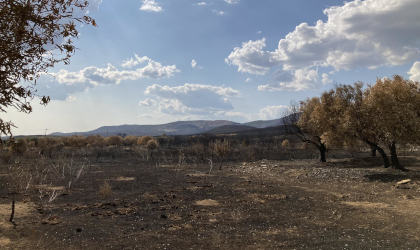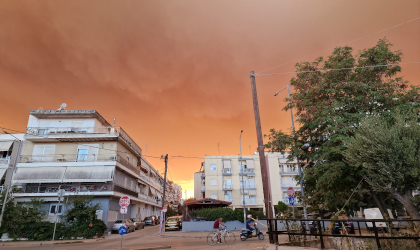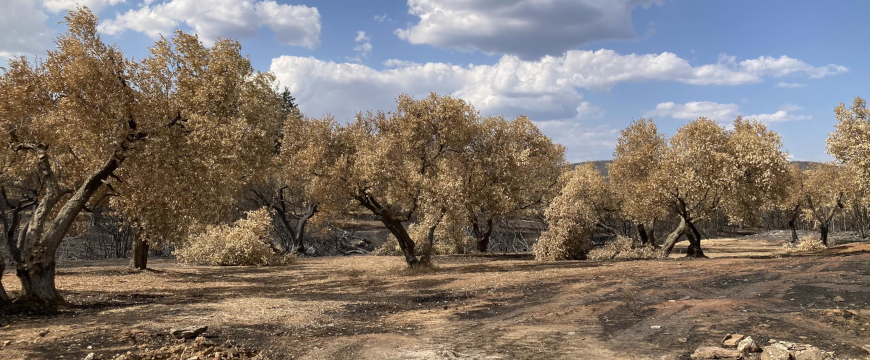After a megafire burned across the southern part of the regional unit of Evros in northeastern Greece for 17 days, olive farmers and experts are assessing losses and considering steps toward regeneration. Fires around the Dadia national park and the city of Alexandroupoli merged in the largest wildfire ever recorded in Europe, with devastating results.
Firefighters and aircraft from a dozen European countries helped fight the blaze, but in the extremely dry, windy conditions, 20 people and countless wild and domesticated animals were killed, while homes, farm buildings, businesses, beehives, and extensive swaths of forest and farmland, including olive groves, were burned. As other parts of Greece suffered from record-breaking deadly, catastrophic flooding, farmers and other residents of the Evros region were grateful if they received small amounts of rain, and some saw no precipitation at all on their land.
Pavlos Georgiadis, ethnobotanist, forest restoration specialist, and founder of Calypso Organic Single Varietal Extra Virgin Olive Oil, told Greek Liquid Gold the megafire persisted until September 3. While small fires continued to burn even a week later, he added, they were under control. According to Georgiadis, “a total of 120,000 olive trees were lost during the blaze. 90,000 of them are in the area around Makri,” a village west of the city of Alexandroupoli. “I had to evacuate my family from the village of Makri at 3 a.m. Luckily the village was saved at the last minute, as the firefighters managed to push the fire to the north.”
As Georgiadis reported, “30% of the olive trees around Makri are estimated to be burned,” although there is hope that some of these trees will become productive again in the coming years. “Luckily, the fire did not enter the core of the ancient olive grove of Makri, where several hundred trees 500, 800, even 1,200 years old still persist. The full accounting of the damage is still underway.” Even so, Valia Kelidou said tourists fled the area or cancelled vacations there, ending the tourist season and its important economic activity a month earlier than usual.
Although he was posting satellite images on social media to provide the general public with up-to-date information about the location of the fire for more than two weeks, Georgiadis felt “the sheer scale of the megafire event is difficult to grasp: 100,000 hectares of land have been burned to ashes. Two national parks have been affected, and the famous Dadia Forest is gone, almost in its entirety,” drastically altering the natural environment. Yet in a sense the extent of the disaster did not surprise him, given “the lack of climate adaptation strategies in the region.”

Dimitris Adamidis, owner of Konos Olive Hill in Makri, told Greek Liquid Gold “we still can't believe what has happened to us” after “watching the fire burning the effort of four generations. The fire burned through our whole olive grove, destroying our green terrain and damaging Konos Hill unimaginably. Hundreds of our centenarian Makri olive trees burned to the ground. We still don't know yet how many we have lost permanently.”
“We have lost our warehouse with all of our cultivation and harvest equipment,” Adamidis added. “The damage is irreparable. The second day after the fire was the first time in my life that I got lost inside our olive grove while I was walking around our trees,” disoriented because the grove looked so different. “That was one of the most devastating moments, the first time that I couldn't recognize an olive tree, because it was so smooth, without any of the characteristic wrinkles” they had developed over decades of growth.
“The future is uncertain. Spring will give us some hints for our next moves,” Adamidis suggested, as they see whether burned trees show any signs of rebirth with new green shoots. Even if they do, though, no substantial olive production is expected for three or four years, so severe economic losses are anticipated.
Another olive farmer in Makri, Valia Kelidou, is also hoping for encouraging signs of life from the 2000 trees that burned on her family’s land. Kelidou and the rest of her Kyklopas family business team managed to save their olive mill, and the fire spared 10,000 of their old olive trees. However, the thousands of olive trees burned in their area include the entire groves of many producers who use the Kyklopas mill, and some also lost their homes.
Kelidou and her husband tried to check on their olive groves during the fire, but when they encountered flames three or four meters high, they had to swiftly reverse course. As Kelidou explained to Greek Liquid Gold, “the fire was very close to our factory many times, even just 100 meters away. We have tons of olive oil in there. If it started burning, it would be a catastrophe, because you can’t put water on olive oil. We didn’t sleep for six days to protect the factory and the people around us.”
At one point Kelidou’s mother asked, “What do you want me to put in the car and save?” But with the family’s 40 years of work at stake, she answered, “I don’t want to save anything—only the PC with company documents and five or six bottles of olive oil” for the family to eat.
The Makri area also faced problems with electricity, water, internet, and communications outages as the signal towers in the mountains burned. Dimitris Adamidis said his electricity and water returned only after 18 days, and even then his partly melted irrigation hoses did not help him water his groves. Others were able to take advantage of air conditioning earlier, and Kelidou reported that they “stayed inside with their AC on because of the terrible air quality” for two weeks.

As Pavlos Georgiadis explained, “the region will experience heavy impacts in the long term. This does not only have to do with the loss of income, but also with the loss of biodiversity, fertile soils and water resources. All these are important factors for the health and resilience of the ancient olive grove. The microclimate of the region has obviously been altered.”
“But my biggest concern,” Georgiadis continued, “is the genetics of our ancient olive grove. Will the burned trees be replaced by the indigenous olive variety, which is adapted to the local climate, or will the farmers replace them with new commercial varieties? It is unknown whether appropriate and safe treelets exist in the local nurseries in the numbers that are required.”
Georgiadis’s 20 years of forest restoration experience have shown “that nature has an incredible regenerative power. The root system of the burned plants has suffered, but it is still alive, containing all the genetic and biochemical information for regrowth. We will be able to witness this modest re-greening next spring. I hope that human activities will allow the vital space and time that nature needs to heal its wounds and get back to life. Knowledge and collaboration are the bedrock of our hope.”
Thanks to Pavlos Georgiadis for the photos of olive trees that appear with this article, and to Valia Kelidou for the photo of Alexandroupoli.
All businesses, organizations, and competitions involved with Greek olive oil, the Mediterranean diet, and/or agrotourism or food tourism in Greece, as well as others interested in supporting Greeks working in these sectors, are invited to consider the advertising and sponsorship opportunities on the Greek Liquid Gold: Authentic Extra Virgin Olive Oil website. The only wide-ranging English-language site focused on news and information from the Greek olive oil world, it has helped companies reach consumers in more than 220 countries around the globe.



